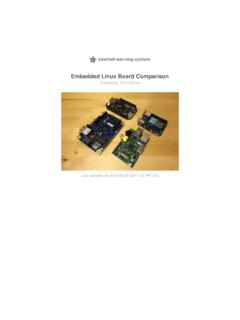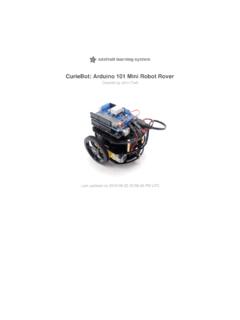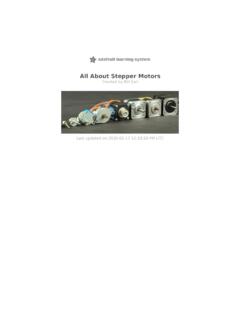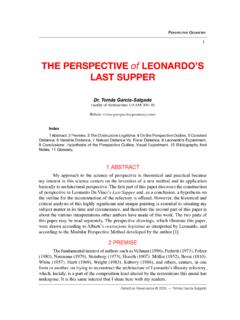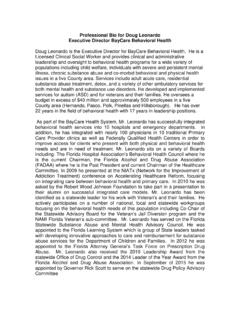Transcription of Create an Infrared Controlled Mouse with Arduino Micro ...
1 Create an Infrared Controlled Mouse with Arduino Micro , Leonardo,or YunCreated by Chris YoungLast updated on 2018-08-22 03:46:58 PM UTC233335557791010 Guide ContentsGuide ContentsOverviewIntroductionHardware NeededSoftware LibrariesAssembling the HardwareWiring the Arduino MicroWiring Leonardo or YunConfiguring the DeviceUsing the Adafruit Mini Remote ControlDetermining Your Own CodesSource Code ListingsCode for Arduino Micro /Leonardo/Yun Adafruit 2 of 13 OverviewIntroductionIn this tutorial we're going to use the Mouse and keyboard emulation abilities of a variety of Arduino devices combinedwithin Infrared receiver to make a remote control Mouse with some keyboard commands thrown in for good are a variety of reasons why you might
2 Want to Create an Infrared remote control Mouse or keyboard. Supposeyou're making a PowerPoint presentation and you don't want to be stuck standing next to the laptop as you clickthrough the slides. Or perhaps you've set up your Raspberry Pi as a media server or you have some sort of HomeTheater PC connected to your for me the ability to do Mouse and keyboard remotely is much more personal. As a result of my disability, Icannot use a traditional Mouse . I control my computer using dictation software. However the Mouse commands for thatsoftware have limits or are somewhat inconvenient to use. I can however use a traditional TV remote by poking at thebuttons with a stick in my mouth.
3 I originally developed this project because it helps me overcome my disability andallows me to do productive things like write tutorials for the Adafruit Learning System. If you're interested, here is a linkto my personal blog about how this project was originally developed ( ). I use it every day and Icould not have written this tutorial without NeededWe originally intended this tutorial to have support for Pro Trinket as well as any ATmega32u4 based boards such asthe Arduino Leonardo, Arduino Micro , and Arduino Yun. However there appeared to be some conflicts between IRLibinfrared library and the Pro Trinket Mouse and keyboard libraries.
4 If we can resolve those problems at a later date wewill update this tutorial. For now we are sticking to the ATmega32u4 based boards. We will be using Arduino Microhowever the code will work identically with an Arduino Leonardo and the Leonardo portion of the Arduino Yun. You will need an IR sensor such as the TSOP38238 shown at the will need some sort of Infrared remote control. All of our example code has been written for the Adafruit MiniRemote Control shown on the right but you can modify the code to use any ordinary TV remote if it uses a protocolsupported by it is not 100% necessary, we will also add 2 NeoPixel's as indicator lights that will help you know whether ornot you are in Mouse mode or keyboard mode and if you have pressed the Control, Alt, or Shift buttons.
5 The NeoPixelalso indicates whether or not you are dragging the Mouse or clicking LibrariesThe Mouse and keyboard libraries for the Leonardo, Micro , and Yun are already installed as part of the standardArduino IDE. You can find more about these librariesat ( )You also need the IRLib2 Infrared Library for Arduino available on GitHub. ( ). For an introduction tousing this library, see our previous tutorial Using an Infrared Library for Arduino ( ). NOTE: These tutorials have been updated for use with IRLib which is not backwards compatible with the originalIRLib you're using NeoPixels as indicator lights you will need down eight the Adafruit NeoPixel Library fromGitHub ( ).
6 Both of these libraries can be downloaded using the buttons below. Adafruit 3 of 13 the tutorial All About Arduino Libraries ( ) on installing the code into your Arduino IntegratedDevelopment Environment (IDE) for your use. Adafruit 4 of 13 Assembling the HardwareWiring the Arduino MicroHere is a schematic of the Arduino Micro showing the IR receiver connected to pin 11. We also have 2 NeoPixels wiredtogether wired to pin 6. Be sure to connect to the input side of the first NeoPixel and connect its output to the input ofthe second NeoPixel. All three devices have +5v and Gnd lines connected to them. The image shows the underneathside of the Arduino Micro because in this instance, it will be easier to wire everything up from the underneath is a photo of the unit assembled.
7 We placed a piece of double stick tape on the back of the Arduino Micro andplaced the parts on the tape. The wires are solid uninsulated wires so you have to be very careful that they do notshort out one another or to the Arduino Micro itself. Ultimately you might want to wrap electrical tape around the entirepackage leaving holes for the IR receiver and the NeoPixels. Or perhaps you might encase the entire assembly insugru Leonardo or Yun Adafruit 5 of 13 Because the Leonardo and Yun also use the ATmega32u4 processor, they will work identically to the Arduino would wire the receiver to pin 11. The NeoPixel signal wire to pin 6.
8 Also run power and ground to all the the Leonardo is shown below, the Yun pinouts are the same as the Leonardo. Adafruit 6 of 13 Configuring the DeviceIf all we need to do is move the Mouse around and click it using the left click button then you really only need to assignfive buttons on your remote to the up, down, left, and right Mouse movement functions and the click function. Mostremotes have a series of four arrow keys with a select button in the center that can be used for clicking. We howeverare going to go above and beyond and assign as many functions as we can to the Adafruit Mini Remote Control. Weare also going to define two different modes of use: one of them for Mouse commands and the other for a limited setof keyboard commands mostly arrow keys.
9 The full source code can be found in the next page of this the Adafruit Mini Remote ControlHere is an illustration of the commands that we are assigning to the 21 buttons available on our remote. Some of thecommands are duplicated in both Mouse mode and keyboard mode. You switch modes by pressing the "8" buttonwhich is at the lower center of the you are using a different remote, you will need to come up with your own layout assigning buttons to functions. Youmay not want to assign all the buttons we have assigned or you may come up with additional ones that you would liketo is a section of the code we will use.
10 It defines the 32-bit hex values that are transmitted by the various buttonson the remote. A complete source code listing is given on the last page of the tutorial. Adafruit 7 of 13 Five of the buttons are available in both Mouse and keyboard modes. The three buttons across the top are toggle keysfor the Alt, Control, and Shift keys. When you press them once, it holds that modifier key until you press again. You canalso press "5" marked "Rls" for "Release". It releases all of the toggle keys as well as releasing any held down mousebuttons for dragging. In addition to the three modifier keys and the release button, the mode switch button "8" is alsoavailable in both the keys are toggle keys, I found it easy to forget whether I left the shift key held or not.


